Citation: Steve Cook, Duncan Watson. Volatility in the Housing Market: Evidence on Risk and Return in theLondon Sub-market[J]. Quantitative Finance and Economics, 2017, 1(3): 272-287. doi: 10.3934/QFE.2017.3.272
| [1] | Ann De Vos, Tine Bynens, Joëlle Rosseels, Catherina Coun, Julia Ring, Frank Madeo, Marie-Christine Galas, Joris Winderickx, Vanessa Franssens . The peptidyl prolyl cis/trans isomerase Pin1/Ess1 inhibits phosphorylation and toxicity of tau in a yeast model for Alzheimer's disease. AIMS Molecular Science, 2015, 2(2): 144-160. doi: 10.3934/molsci.2015.2.144 |
| [2] | Elisa Isopi, Giuseppe Legname . Pin1 and neurodegeneration: a new player for prion disorders?. AIMS Molecular Science, 2015, 2(3): 311-323. doi: 10.3934/molsci.2015.3.311 |
| [3] | Madhurima Roy, Chandana Paul, Nilasish Pal, Tanima Saha, Nirmalendu Das . Pharmacological and therapeutic inventory of fungi in cancertherapy—A comprehensive review. AIMS Molecular Science, 2025, 12(1): 67-98. doi: 10.3934/molsci.2025005 |
| [4] | Richard C. Petersen . Triclosan antimicrobial polymers. AIMS Molecular Science, 2016, 3(1): 88-103. doi: 10.3934/molsci.2016.1.88 |
| [5] | Alveena Batool Syed, James Robert Brašić . Nuclear neurotransmitter molecular imaging of autism spectrum disorder. AIMS Molecular Science, 2019, 6(4): 87-106. doi: 10.3934/molsci.2019.4.87 |
| [6] | Yutaka Takihara, Ryuji Otani, Takuro Ishii, Shunsuke Takaoka, Yuki Nakano, Kaori Inoue, Steven Larsen, Yoko Ogino, Masashi Asai, Sei-ichi Tanuma, Fumiaki Uchiumi . Characterization of the human IDH1 gene promoter. AIMS Molecular Science, 2023, 10(3): 186-204. doi: 10.3934/molsci.2023013 |
| [7] | Birgitte Zeuner, Isabel González-Delgado, Jesper Holck, Gabriel Morales, María-José López-Muñoz, Yolanda Segura, Anne S. Meyer, Jørn Dalgaard Mikkelsen . Characterization and immobilization of engineered sialidases from Trypanosoma rangeli for transsialylation. AIMS Molecular Science, 2017, 4(2): 140-163. doi: 10.3934/molsci.2017.2.140 |
| [8] | Ashok Chakraborty, Anil Diwan . Molecular mechanisms of neurodegenerative disease (NDD). AIMS Molecular Science, 2023, 10(3): 171-185. doi: 10.3934/molsci.2023012 |
| [9] | Andrés Molero-Chamizo, Guadalupe Nathzidy Rivera-Urbina . Molecular mechanisms involved in taste learning and memory. AIMS Molecular Science, 2017, 4(4): 389-398. doi: 10.3934/molsci.2017.4.389 |
| [10] | Naba Hasan, Waleem Ahmad, Feroz Alam, Mahboob Hasan . Ferroptosis-molecular mechanisms and newer insights into some diseases. AIMS Molecular Science, 2023, 10(1): 22-36. doi: 10.3934/molsci.2023003 |
Bio-based and biodegradable polymers are continuously object of a great interest from academy and industry due to the necessity to substitute traditional plastics derived from not-renewable resources and often resistant to degradation with new materials obtained from biomass and environmentally friendly [1,4]. In particular, notable efforts are nowadays evident to find new solutions for the substitution of important aromatic polyesters, such as poly(ethylene terephthalate) (PET), poly(propylene terephthalate) (PPT), and poly(butylene terephthalate) (PBT), which cover a significant market of plastics in Europe, due to their excellent thermal and mechanical properties, low permeability, chemical resistance, and low costs. In particular, PET is the sixth more requested polymers in Europe, with a demand of 3000 ktonne in 2012, and is used in bottle containers, food packaging, textile fibers, engineering plastics and electronics [5].
The diols used to produce PET, PPT and PBT, i.e. 1,2-ethanediol, 1,3 propanediol, and 1,4butanediol (BD), are now available by new routes from biobased resources [6]. On the other hand, for the production of terephthalic acid (TPA) from renewable resources, some green pathways have been developed [6], for example by starting from terpenes [7], thought a really convenient route from an industrial point of view has not yet been found. For this reason, also sustainable substitutes of terephthalic acid have been proposed, such as 2,5-furandicarboxylic acid, ferulic acid, and vanillic acid [8,9,10,11,12].
Another possible building block, alternative to terephthalic acid, is the 1,4-cyclohexanedicarboxylic acid (CHDA). It is exactly the aliphatic counterpart of the aromatic TPA and can be prepared from bio-based terephthalic acid, starting from limonene and other terpenes[13]. Moreover, CHDA or its dimethyl ester (dimethyl 1,4-cyclohexanedicarboxylate, DMCD) present some further advantages with respect to TPA as monomer in polyester synthesis. Firstly, aliphatic-alicyclic copolymers resulted to have a significantly high biodegradability, notably larger than that of similar copolymers containing terephtahlic units [14,15,16]. Moreover, the polymers derived from CHDA or DMCD can be prepared by modulating the amount of the cis and trans isomers of the 1,4-cycloaliphatic rings (see
 Scheme 1. Trans and cis configurations of CHDA unit.
Scheme 1. Trans and cis configurations of CHDA unit.
For all these reasons, the use of CHDA or DMCD to prepare the aliphatic counterpart of PET, PPT, and PBT polyesters is a very attracting topic. Therefore, this work focuses on the synthesis and characterization of poly(ethylene 1,4-cyclohexanedicarboxylate) (PECHD) and poly(propylene 1,4-cyclohexanedicarboxylate) (PPCHD) (
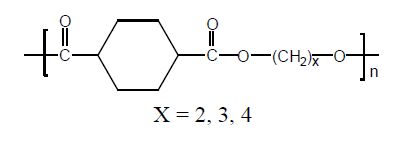 Scheme 2. Molecular structure of the aliphatic polyesters.
Scheme 2. Molecular structure of the aliphatic polyesters.
Two commercial samples of DMCD with 22% and 100% of trans isomer content, 1,2-ethanediol, 1,3-propanediol, 1,4-butanediol, and titanium tetrabutoxide (TBT) (all from Aldrich chemicals) were high purity products, used as received. PET, PPT and PBT were previously prepared in our laboratory according to the procedure described in reference [25] (for PET), [26] (for PPT), and [27] for PBT.
The aliphatic polyester samples were synthesised in a two-stage process, from dimethyl 1,4-cyclohexane dicarboxylate (DMCD) with two different ratios of cis/trans and different diols (1,2-ethanediol, 1,3-propanediol, 1,4-butanediol). The different percentages of the trans isomer of the cyclohexylene ring (90 and 50 mol%) were obtained by a convenient mixture of two DMCD monomers, 100 and 22 mol % of trans.
The samples are named with the code PxCHDy where x is a letter indicating the diol used (E=1,2-ethanediol, P = 1,3-propanediol, B = 1,4-butanediol) and y is the percentage of the aliphatic rings, derived from DMCD, in trans configuration. The aromatic samples are indicated with the PxT code, where also in this case x is the letter indicating the diol monomeric structure.
The syntheses were performed in accordance with the procedure described in reference [17]. As an example, the synthesis of PPCHD90 is here described.
DMCD 100 mol% trans (26.15 g, 0.131 mol), DMCD 22 mol% trans (3.85 g, 0.019 mol), (1,3-propanediol (15.96 g, 0.210 mol) and TBT (0.04 g, 0.12 mmol) were placed into a round-bottomed wide-neck glass reactor (250 mL capacity). The reactor was closed with a three-neck flat flange lid equipped with a mechanical stirrer and a torque meter that gives an indication of the viscosity of the reaction melt. The reactor was immersed into a salt bath preheated to 200 °C. The first stage was conducted at atmospheric pressure under nitrogen atmosphere and the mixture was allowed to react during 120 minutes under stirring with continuous removal of methanol. The second stage was started to gradually decreasing the pressure to 0.4 mbar while the temperature was raised to the final temperature of 220 °C. These conditions were reached within 60 minutes, using a linear gradient of temperature and pressure, and maintained during 180 minutes.
Before investigation, PxT and PxCHD90 samples were purified. PxT samples were dissolved in a mixture of chloroform/1,1,1,3,3,3-hexafluoro-2-propanol (HFIP) (90/10 vol%) and precipitated in methanol; PxCHD90 samples were dissolved in chloroform and precipitated in methanol.
The 1H NMR spectra of PxCHDy samples were recorded at room temperature on samples dissolved in CDCl3 using Varian Mercury 400 spectrometer, the proton frequency being 400 MHz. Chemical shifts are in part per million (ppm) down-field from TMS.
Molecular weights (expressed in equivalent polystyrene) were determined by gel permeation chromatography (GPC) using a HP Series 1100 liquid chromatography instrument equipped with a PL gel 5μ Mixed-C column and refractive index as detector. Chloroform/HFIP (98/2 vol%) mixture was used as eluent for PxT samples and chloroform for PxCHDy samples.
Thermogravimetric analysis was performed using a Perkin-Elmer TGA7 thermobalance under nitrogen atmosphere (gas flow 40 mL·min−1) at 10 °C·min−1 heating rate from 40 °C to 900 °C. The temperature of the maximum degradation rate (TD), corresponding to the maximum of the differential thermogravimetric curve, was calculated.
ATR FT-IR analysis was conducted over the wavenumber range 650-4000 cm−1 using a Perkin Elmer Spectrum One FT-IR spectrometer equipped with a Universal ATR Sampling accessory. Before analysis, some samples were prepared in Differential Scanning Calorimetry (DSC) with the following thermal treatments: first heating scan at 20 °C·min−1 to a temperature 40 °C higher than melting peak, in order to completely melt the polymer, and cooling scan at different rates to obtain polymers with different crystallization degree.
The wide angle X-ray scattering (WAXS) data were collected with X’PertPro diffractometer equipped with a copper anode (Kα radiation, λ = 1.5418 Å). The data were collected in the 2θ range of 5-60° by means of X’Celerator detector. The measurements were performed on samples prepared in DSC with the following thermal treatment: first heating scan at 20 °C·min−1 to a temperature 40 °C higher than the melting peak, in order to completely melt the polymer, and cooling scan at 1 °C·min−1 to 20 °C.
The calorimetric analysis was carried out by means of a Perkin-Elmer DSC6 for measurements in non-isothermal conditions and by means of a Perkin-Elmer DSC7, equipped with a liquid sub ambient accessory, for measurements in isothermal conditions. High purity standards were used in calibrating the instrument and measurements were performed under nitrogen flow (gas flow 20mL·min−1)
In non-isothermal analysis, the samples (5-10 mg) were heated at 20 °C·min−1 to different temperatures varying from 180 to 280 °C, chosen 40 °C higher than the melting peak of each sample, in order to cancel the previous thermal history, kept at this temperature for 1 min and then cooled to −40 °C at 10 °C·min−1. After this thermal treatment, the sample were analyzed by heating to 180-280 °C at 10 °C·min−1 (2nd scan). During the cooling scan, crystallization temperature (Tc) and enthalpy of crystallisation (ΔHc) were measured. During the 2nd scan the glass transition temperature (Tg), the eventual cold crystallization temperature (Tcc) and enthalpy (ΔHcc), the melting temperature (Tm) and enthalpy of fusion (ΔHm) were determined.
Isothermal crystallization experiments were carried out on PxCHD90 as follows: melting at 185-200 °C (at about a temperature 40 °C higher than Tm) according to the sample characteristics, holding for 1 min at this temperature, fast cooling to the selected crystallization temperature Tc, isotherm at Tc long enough to complete the crystallization process and heating at 10°C·min−1 in order to observe the melting process.
Samples for dynamic mechanical measurements were obtained by injection molding in a Mini Mix Molder (Custom Scientific Instruments) equipped with a rectangular mold (30 × 8 × 1.6 mm). The molded samples were rapidly cooled in water and then dried in an oven at 50 °C under vacuum overnight. Dynamic mechanical measurements were performed with a dynamic mechanical thermal analyzer (Rheometrics Scientific, DMTA IV), operated in the dual cantilever bending mode, at a frequency of 3 Hz and a heating rate of 3 °C∙min−1, over a temperature range from −120 °C to a final temperature varying from 100 to 150 °C, according to the sample characteristics.
The synthetic procedure used to prepare the aliphatic PxCHDy polyesters is a traditional two-step polycondensation carried out in the presence of a catalyst. As reported in the experimental part, by starting from an adequate physical mixture of the two components it is possible to obtain polymers with the desired final stereochemistry of the aliphatic rings. Here, for each polymer, two trans contents have been chosen, 50 and 90 mol%, as reported in Table 1. These two different percentages enable us to have different thermal properties of the materials.
| Samples | Trans % of the ring in the polymer a) | Mw × 10-3 b) | Mw/Mn b) |
| PECHD50 | 53 | 84.1 | 2.5 |
| PPCHD50 | 53 | 62.4 | 2.4 |
| PBCHD50 | 52 | 88.6 | 2.8 |
| PECHD90 | 87 | 85.6 | 2.5 |
| PPCHD90 | 87 | 65.6 | 2.5 |
| PBCHD90 | 91 | 54.9 | 2.3 |
| PET | - | 55.0 | 2.4 |
| PPT | - | 60.7 | 2.8 |
| PBT | - | 110.0 | 2.6 |
| a) Calculated by 1H NMR; b) Measured by GPC in CHCl3 for PxCHD samples and in CHCl3/HFIP (98/2 vol%) mixture for PxT samples. | |||
Proton NMR analyses were carried out in order to check the molecular structure and the cis/trans isomeric ratio of the aliphatic samples. As an example, Figure 1 shows the 1H NMR spectrum of the PECHD90 sample, where the signal assignation is reported. The molecular structure is confirmed. The same result has been obtained for all the aliphatic samples (spectra not shown). For PECHD90 it is notable that the signals due to the chain ends are visible in the insert of Figure 1 together with the signals due to the presence of a small amount of diethylene glycol units (O-CH2-CH2-O-CH2-CH2-O-) (DEG) in the polymer chain. An estimation of their amount indicates that the DEG percentage is about 2 mol%. Minor amounts (≤3%) of DEG units are commonly found in ethylene glycol based polyesters, such as PET, where they appear as a consequence of etherification side reactions taking place during the transesterification step. The presence of such units is known to have deleterious effects on thermal transition temperatures of the polyester [28,29].
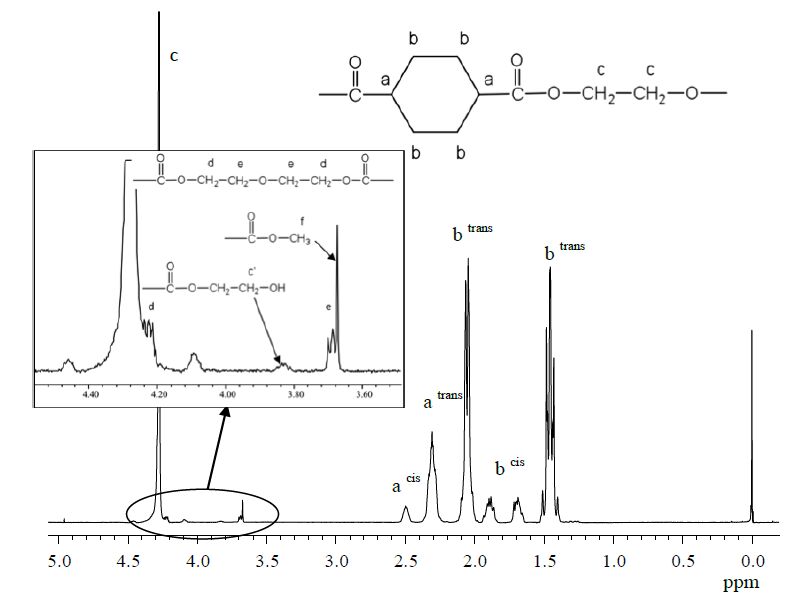 Figure 1. H NMR spectrum of PECHD90 sample with H assignation.
Figure 1. H NMR spectrum of PECHD90 sample with H assignation.
The trans and cis signals appear in the range of 1.3-2.6 ppm and are clearly resolvable. The ratio of the areas of the signals centered at 2.3 (trans isomer) and 2.5 (cis isomer) ppm has been used to calculate the trans percentage, according to the procedure described in ref. 17. Moreover, the NMR analysis confirms that no isomerization from trans to cis form occurs at the conditions used for the polymerization process. Indeed, the 1,4-cyclohexylene ring could isomerize towards the thermodinamically stable cis/trans ratio equal to 34/66, during polymer synthesis, if an acid environment is present or during thermal treatments carried out at temperatures higher than 260 °C and for longer than 1 h [30]. These conditions are not present in the polymerization medium.
The possibility of distinguishing between cis and trans isomers is investigated also by using ATR-FTIR analysis. The literature does not report clear indications about this topic. Firstly, the effect of the crystallinity has been evaluated: the analyses carried out on the same sample with different degrees of crystallinity, obtained by different cooling rates from the melt in DSC, do not show any changes in the spectra. Therefore, it is possible to neglect the effect of different degrees of crystallinity in FTIR analysis.
Figure 2 shows the ATR-FTIR spectra recorded for PPCHD90 and PPCHD50, analysed as obtained.
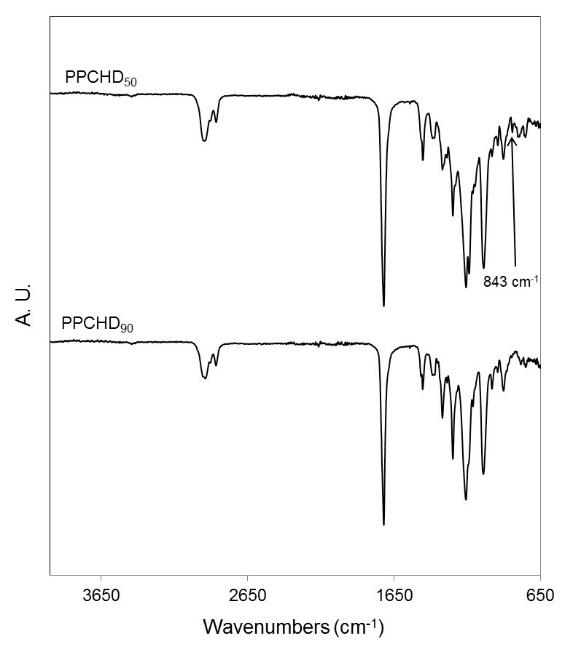 Figure 2. ATR-FTIR spectra of PPCHD90 and PPCHD50.
Figure 2. ATR-FTIR spectra of PPCHD90 and PPCHD50.
Typical bands attributed to the aliphatic C-H stretch at 2940-2870 cm−1 and -CH2 bending band at 1450 cm−1 are present. The strong carbonyl absorbance at 1720 cm−1 is evident as well as the absorbance due to the C-O bond centred at 1040 cm−1 and 1160 cm−1. By a careful comparison between the two spectra it is noteworthy that the spectrum of the specimen with the highest cis content (PPCHD50) presents a band at 843 cm−1 which does not exist in the corresponding PPCHD90 spectrum. The same result has been obtained by carefully checking the spectra obtained for the PECHDy and PBCHDy samples. Therefore, it is possible to hypothesize that the peak at 843 cm−1 is due to the cis isomer in the PxCHD50 samples. A similar result has been obtained in [31].
Concerning the molecular weights reported in Table 1, it is evident that all the aliphatic polyesters have high and similar Mw and, then, can be suitable for a comparison in terms of thermal behavior.
Thermal stability of the samples was analyzed using TGA in nitrogen atmosphere. As visible in Figure 3, the aliphatic polyesters have a notable stability, as the degradation process begins above 320 °C. It occurs in a single step up to a complete weight loss. The temperatures of the maximum degradation rate (TD), reported in Table 2, confirm this behaviour for all the PxCHDys. Moreover, the results exclude also an influence of the stereochemistry of the aliphatic ring on the stability of the polymers, as already observed for other polyesters containing the 1,4-cycloaliphatic units [18].
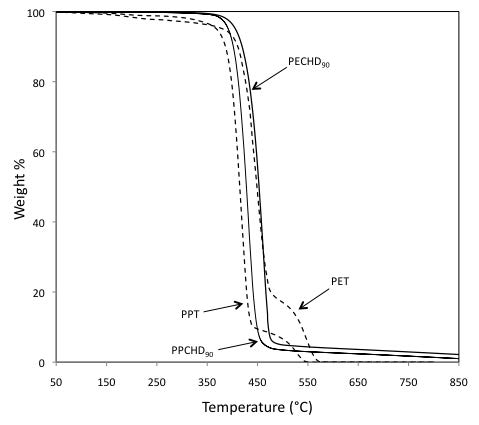 Figure 3. Thermogravimetric curves obtained in nitrogen at 10 °C·min−1 of PET, PECHD90, PPT and PPCHD90 samples.
Figure 3. Thermogravimetric curves obtained in nitrogen at 10 °C·min−1 of PET, PECHD90, PPT and PPCHD90 samples.
| Samples | TDa) | Tcb) | ΔHcb) | Tgc) | Tccc) | ΔHccc) | Tmc) | ΔHmc) | Tmo d) |
| (°C) | (°C) | (J·g-1) | (°C) | (°C) | (J·g-1) | (°C) | (J·g-1) | (°C) | |
| PECHD50 | 460 | - | - | 14 | - | - | - | - | - |
| PPCHD50 | 431 | - | - | -1 | - | - | - | - | - |
| PBCHD50 | 433 | - | - | -9 | - | - | - | - | - |
| PECHD90 | 462 | - | - | 24 | 113 | 3 | 145 | 4 | Nd e) |
| PPCHD90 | 432 | 71 | 19 | 7 | 67 | 11 | 140 | 29 | 152 |
| PBCHD90 | 433 | 132 | 43 | 5 | - | - | 150–158 | 46 | 170 |
| PET | 451 | 188 | 34 | 82 | - | - | 254 | 31 | 272 |
| PPT | 418 | 174 | 47 | 54 | - | - | 230 | 54 | 241 |
| PBT | 408 | 192 | 57 | 42 | - | - | 217–223 | 55 | 233 |
| a)Temperature of the maximum degradation rate measured in TGA under nitrogen flow at 10 °C·min−1; b) Measured in DSC during the cooling scan at 10 °C·min−1; c) Measured in DSC during the second heating scan at 10 °C·min−1; d) calculated by Hoffmann-Weeks equation; e) not determined. | |||||||||
By comparing aliphatic materials with the corresponding aromatic polymers, it is evident that the 1,4-cyclohexylene units improve the thermal stability of the materials with respect to the terephthalate units. The same observations have been made, for example, by Wang et al. [32] for copolymers based on PET: the introduction of C6 aliphatic rings increases the thermal stability of PET of 5-10 degrees, accordingly to the 1,4-cyclohexylene unit content. Moreover, also the substitution of the butylene units in PBCHD with another aliphatic ring, in PCCD, contribute to further stabilize the material [33].
In a similar way, the thermal stability of some aliphatic-aromatic random copolyesters increases as the cyclic units, obtained from CHDM, increase [34].
Finally, it is noteworthy that polyesters derived from ethanediol (PECHD and PET) present TD values notable higher with respect to the TD values of the other aliphatic and aromatic specimens, respectively (PECHD 460-462 °C vs PPCHD 431-432 and PBCHD 433 °C; PET 451 vs PPT 418 and PBT 408 °C). The higher thermal stability of PET with respect to PPT and PBT has been already observed in literature and attributed to the different stability of the end groups created after chain cleavage [35]. The instability of the vinyl endgroups in PET results in a net loss of glycol units, which improves the equilibrium stoichiometry during degradation. This provides a competing, productive mechanism that partially compensates for the decrease in conversion by chain cleavage. On the other hand, in PTT and PBT allyl and butenyl are relatively stable chain-terminating endgroups and the overall stoichiometry does not change as a result of thermal chain cleavage. The same behaviour can be imputed to the PECHDs with respect to PPCHD and PBCHD samples.
Figure 4-6 show the DSC curves of the cooling and second heating scans of the PxCHDy samples, together with those of PxT specimens. All the DSC data are collected in Table 2.
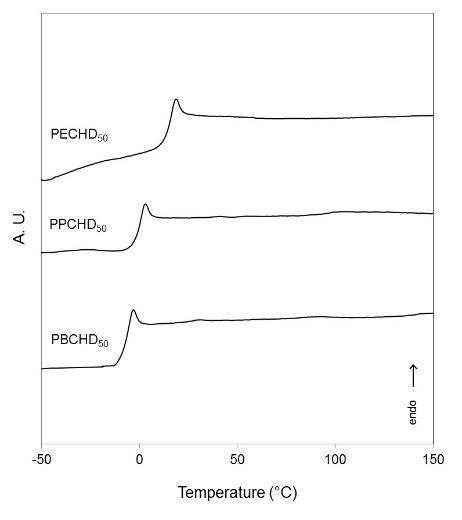 Figure 4. DSC traces obtained on PxCHD50 samples during the second heating scan.
Figure 4. DSC traces obtained on PxCHD50 samples during the second heating scan.
By considering the second heating scans of the PxCHD50 specimens (Figure 4), it is noteworthy that these samples are fully amorphous, whereas the PxCHD90 specimens (Figure 5-6), mainly PPCHD90 and PBCHD90, are able to crystallize. This behaviour confirms that the trans configuration of the aliphatic C6 rings improves the capacity of the samples to reach an ordered state. Indeed in the preferred chain conformation of the 1,4-cyclohexylene units, the trans configuration is more stretched and symmetrical than cis one, thus suitable for good chain packing. The cis configuration, instead, introduces non-linear moieties and kinks along the main chain, which result to hinder formation of stable and perfect crystals [17,19,33].
 Figure 5. DSC traces obtained on PxCHD90 and PxT samples during the cooling scan.
Figure 5. DSC traces obtained on PxCHD90 and PxT samples during the cooling scan.
 Figure 6. DSC traces obtained on PxCHD90 and PxT samples during the second heating scan.
Figure 6. DSC traces obtained on PxCHD90 and PxT samples during the second heating scan.
Concerning the amorphous phase, PxCHD samples have Tg values located in the range from −9 to 24 °C. From Table 2 and Figure 7a it is notable that PxCHD50 samples are characterized by glass transition temperatures that are about 10 °C lower than those of PxCHD90 specimens. As an example, PBCHD has a Tg of −9 °C when contains 50 mol% of trans isomer and a Tg of 5 °C when the trans amount increases to 90 mol%. The higher Tg values in the PBCHD90 series can be due to the presence of a high amount of trans isomer, more rigid than the cis one, and to the crystallinity, mainly for PPCHD90 and PBCHD90 samples. Both factors, trans isomer and crystallinity, contribute to increment the rigidity of the chains and to increase the glass transition temperature. Finally, it is notable that Tg decreases with the lengthening of the aliphatic chain, as in PxT series, due to a larger flexibility of a longer methylene sequence.
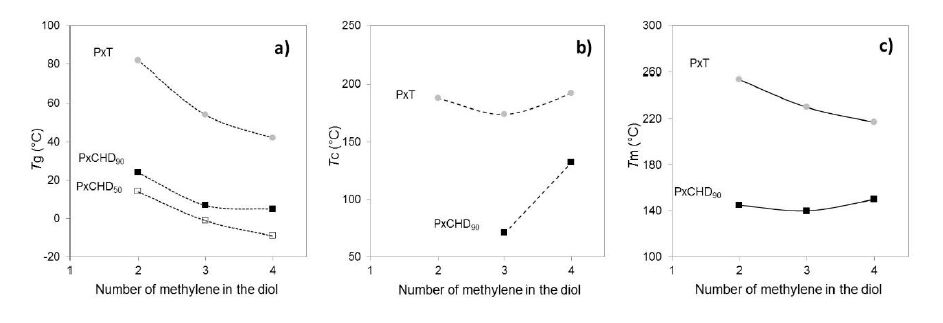 Figure 7. Trend of Tg (Figure 7a), Tcc (Figure 7b) and Tm (Figure 7c) as a function of the number of methylene groups in the aliphatic chain of PxCHDy and PxT series.
Figure 7. Trend of Tg (Figure 7a), Tcc (Figure 7b) and Tm (Figure 7c) as a function of the number of methylene groups in the aliphatic chain of PxCHDy and PxT series.
Concerning the crystalline phase, for PxCHD90 series it is noteworthy (Figure 5,6) that the sample containing a short aliphatic chain (a sequence of 2 methylene units in PECHD90) is characterized by a very low crystallinity, when analyzed in DSC at 10 °C·min−1 of cooling and heating rates. An analogous trend is evident by comparing crystallization enthalpies of PET with those of PPT and PBT. On the other hand, PPCHD90 specimen crystallizes partially during the cooling scan and completes its crystallization during the second heating scan, indicating a relatively slow crystallization rate. This behaviour is confirmed in Figure 7b, where the Tc datum for PPCHD90 is very low. PBCHD90, instead, crystallizes only during the cooling scan, suggesting a higher capability in reaching an ordered state. Therefore, it is evident that in the PxCHD90 series the length of the aliphatic chain strongly influences the crystallization rate and degree of crystallinity, which increase with the lengthening of the -CH2- sequences. These differences in ability to crystallize are not so evident for the PxT series (Figure 5). Moreover, the difficulty in crystallizing of PECHD90 could be due also to the presence of DEG units that cause a decrement of the crystallization rate, as observed for PET [29]. However, when slower cooling rate are used (1 °C·min−1), also the PECHD90 specimen is able to reach a significant level of crystallinity, as reported in Table 3.
| Samples | Tca) | ΔHca) | Tgb) | Tccb) | ΔHccb) | Tmb) | ΔHmb) |
| (°C) | (J·g-1) | (°C) | (°C) | (J·g-1) | (°C) | (J·g-1) | |
| PECHD90 | 91 | 23 | 27 | - | - | 143 | 23 |
| PPCHD90 | 101 | 41 | 11 | - | - | 130–141 | 41 |
| PBCHD90 | 142 | 42 | - | - | - | 155 | 42 |
| a)Measured in DSC during the cooling scan at 1 °C·min−1; b) Measured in DSC during the second heating scan at 10 °C·min−1. | |||||||
From Figure 6 it is also visible that PBCHD90 presents multiple and complex melting processes that have been attributed to melting-recrystallization-remelting processes occurring during the calorimetric scan [17]. The same behaviour takes place in PBT in the analysis at 10 °C·min−1. This is typical of the polymers, especially polyesters that are characterized by a relatively high crystallization rate and can rearrange their crystalline state along the DSC scan. In any case, due to this complex melting behavior, it should be emphasized that the DHm given in Table 2 are only indicative because they do not refer to a simply melting phenomenon.
Figure 7 can be also useful to compare the thermal behaviour of PxCHDy samples with their aromatic counterparts. It is important to notice that glass transitions of aromatic polyesters are considerably higher than those of the corresponding aliphatic polyesters (Figure 7a). As an example, PBT has a Tg of 42 °C, which is about 40 °C higher than the Tg of the semicrystalline and amorphous PBCHDs (Tg = 5 and −9 °C, respectively). The same behavior is visible for PET and PPT with respect to the aliphatic counterparts. Moreover, it is notable that aromatic polyesters are characterized by very high values of the Tc and Tm (Figure 7b and 7c). All these differences can be justified by considering that in polyesters based on terephthalic acid, the coplanarity between the carbonyl and phenyl groups restricts the rotational angles about Cphenyl-CO to 0 and 180 °, even if rotations about the terephthaloyl residue virtual bond, resulting in nonplanar conformations, are also probable, with a barrier which increases for rotation angles increasing from 0 to 90 ° [36,37,38]. The planar conformation favors the molecular packing of the chains in the crystal, and enhances the attractive intermolecular interactions between the ester groups of neighboring chains. As a result, the aromatic polyesters exhibit high melting points [38]. The low flexibility of the chains, moreover, induces a high Tg value. On the other hand, in PxCHD the presence of the aliphatic ring, in chair or boat conformations, excludes the planarity of the CO-C6 system; moreover the cyclohexyl groups are conformationally more mobile than the rigid phenyl ring. For these reasons the melting temperatures and Tg values are considerably lower [39].
In order to better understand the crystallization behaviour, the X-ray diffraction analysis has been performed on the PxCHD90 samples, cooled from the melt at 1 °C·min−1 in DSC. Figure 8 shows the spectra where it is notable a high level of crystallinity for all the samples and the presence of three different crystalline phases, depending on the chain length of the diol. A more in depth study on these different crystalline phases could justify the trend of melting temperatures reported in Figure 7c.
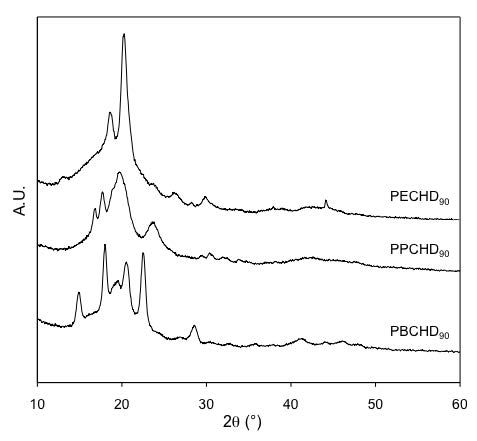 Figure 8. WAXD analysis carried out on PxCHD90 samples non-isothermally crystallized in DSC (cooling from the melt at 1 °C·min−1).
Figure 8. WAXD analysis carried out on PxCHD90 samples non-isothermally crystallized in DSC (cooling from the melt at 1 °C·min−1).
As a conclusion, PxCHD samples can be prepared in amorphous or semicrystalline state, according to the cis/trans ratio of the cyclohexylene rings present along the chain. They are characterized by Tg and Tm values notably lower than those of their aromatic counterparts (about 60 and 100 °C lower, respectively), due to differences in chemical structure of the aliphatic and aromatic rings.
The crystallization processes of the PxCHD90 samples have been studied in isothermal conditions, in order to better understand their phase behaviour and to obtain some kinetic parameters. This study was performed on purified samples to eliminate impurities that can strongly influence the crystallization process. PPCHD90 and PBCHD90 present the ability of crystallizing in isothermal conditions, whereas PECHD90 is characterized by a crystallization rate that is too slow in the temperature range analysed. Thecrystallization temperatures (Tc), chosen according to the polymer characteristics, are reported in Table 4.
| Samples | Tc (°C) | t1/2 (s) | n | k (s-n) |
| PPCHD90 | 96 | 236 | 2.3 | 1.8 × 10-6 |
| 98 | 265 | 2.3 | 2.5 × 10-6 | |
| 100 | 319 | 2.4 | 7.6 × 10-7 | |
| 102 | 380 | 2.3 | 1.1 × 10-6 | |
| 104 | 462 | 2.4 | 5.3 × 10-7 | |
| PBCHD90 | 138 | 80 | 3.0 | 1.5 × 10-6 |
| 140 | 112 | 2.7 | 1.9 × 10-6 | |
| 142 | 180 | 2.6 | 7.5 × 10-7 | |
| 144 | 280 | 2.7 | 1.9 × 10-7 | |
| 146 | 604 | 2.9 | 8.4 × 10-9 | |
| PET | 201 | 299 | 2.1 | 4.6 × 10-6 |
| 203 | 325 | 2.0 | 7.5 × 10-6 | |
| 205 | 460 | 2.2 | 1.1 × 10-6 | |
| 207 | 480 | 2.2 | 5.0 × 10-6 | |
| 210 | 544 | 2.0 | 3.4 × 10-6 | |
| PPT | 191 | 102 | 2.3 | 2.0 × 10-5 |
| 193 | 122 | 2.2 | 1.7 × 10-5 | |
| 195 | 258 | 2.1 | 6.3 × 10-6 | |
| 197 | 433 | 2.4 | 4.0 × 10-7 | |
| 199 | 551 | 2.5 | 1.2 × 10-7 | |
| PBT | 196 | 72 | 2.6 | 1.2 × 10-5 |
| 198 | 116 | 2.5 | 5.1 × 10-6 | |
| 200 | 219 | 2.4 | 1.4 × 10-6 | |
| 202 | 310 | 2.6 | 2.4 × 10-7 | |
| 204 | 649 | 2.6 | 2.7 × 10-8 |
Figure 9 shows some typical calorimetric traces of the PxCHDy samples that were isothermally crystallized at different temperatures (Tc) and subsequently melted. As discussed for PBCHD in [20], during the heating scan multiple and complex melting processes occur, which are typical of polyesters [40]. Peak I can be associated with the melting of the poorer crystal grew at Tc, peak II can be ascribed to the fusion of crystal actually formed at Tc. Peak III can be explained as due to the melting of the most perfect crystals grown through melting-recrystallization processes. From the analysis of the melting processes, it is possible to extrapolate the Tm° value, which is the equilibrium melting temperature, i.e. the melting temperature of perfect lamellar crystals with an infinite tickness. These data are crucial in order to compare the crystallization rates of the different samples in similar conditions, i.e. at the same undercooling ΔT = Tm° − Tc. Among the most commonly used procedures to evaluate Tm°, the Hoffmann-Weeks method is especially acceptable thanks to its simplicity, through the relationship [41]:
| @{T_{\rm{m}}} = T_{\rm{m}}^ \circ \left( {1 - \frac{1}{\gamma }} \right) + \frac{{{T_{\rm{C}}}}}{\gamma }@ | (1) |
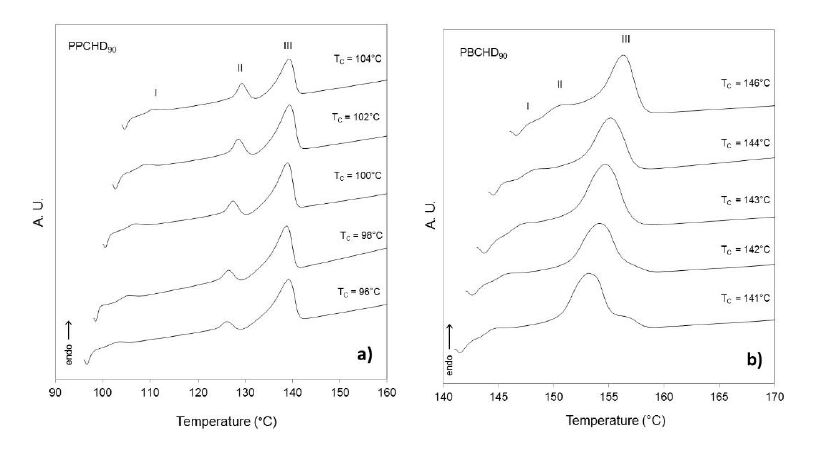 Figure 9. Melting endotherms obtained by DSC on PECHD90 (a) and PBCHD90 (b) samples after isothermal crystallization at the Tc indicated on the curves.
Figure 9. Melting endotherms obtained by DSC on PECHD90 (a) and PBCHD90 (b) samples after isothermal crystallization at the Tc indicated on the curves.
The overall crystallization process has been analyzed by considering the isothermal curves, which report heat flow as a function of time. They were analyzed by the Avrami equation [43,44,45]:
| @{X_{\rm{t}}} = 1 - exp\left[{ - k{{\left( {t - {t_0}} \right)}^n}} \right]@ | (2) |
The double logarithmic Avrami plot for PPCHD90 and PBCHD90 samples shows a good linearity from the beginning to the end of the crystallization. This result can be interpreted as the achievement of the highest possible level of crystal perfection under the crystallization conditions used. Such an interpretation is in agreement with the observed capability of the samples at high trans content to attain a great crystal perfection.
As regards the crystallization mechanism, it is useful to analyze the Avrami exponent. PBCHD90 presents n values between 2.6-3.0 (Table 4) whereas lower values, between 2.3 and 2.4, have been found for PPCHD90. n data around 2.5-3.5 are typical of heterogeneous nucleation and three-dimensional growth, whereas n data lower than 2.5 can be justified by the consideration that the Avrami theory describes only approximately the formation of crystals with large amounts of defects and with peculiar morphologies [46].
Crystallization half-time t1/2 is the time at which the polymer reaches a crystalline fraction equal to 0.5 and is used to compare crystallization rates. This value was obtained by subtracting the induction time t0 that is the time span before crystallization begins at isothermal temperature.
Finally, Figure 10 describes the trend of 1/t1/2 (which is proportional to the crystallization rate) as a function of the undercooling ΔT = Tm° − Tc for the PxCHD90 samples. Only a portion of the expected bell-shaped curve is obtained for each sample, in particular the part of the curve at “low” ΔT or “high” Tc, characterized by a nucleation controlled character.
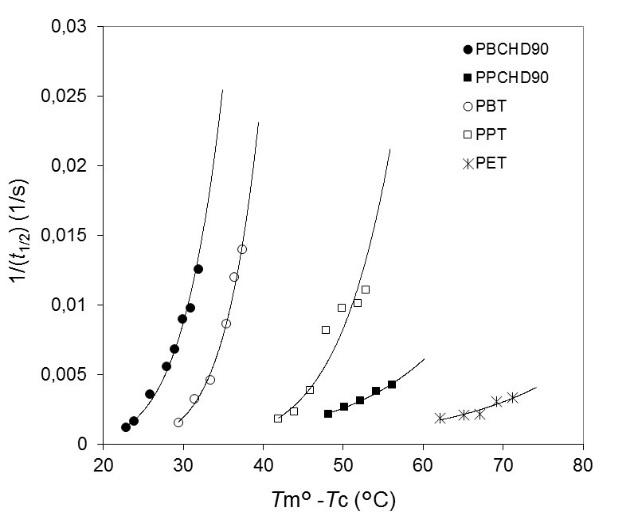 Figure 10. Semicrystallization time as a function of the undercooling for PxCHD90 and PxT samples.
Figure 10. Semicrystallization time as a function of the undercooling for PxCHD90 and PxT samples.
Figure 10 clearly indicates that the crystallization rate of the PxCHD samples is strongly dependent on the diol chain length and increases by increasing the number of methylene units in the diol. Indeed, the macromolecular chain becomes more flexibile and the formation of crystals by chain folding is favored.
By observing the crystallization rate of the aromatic polyesters, it is notable that also in this case the crystallization rate increases from PET to PPT and then PBT, according to kinetic crystallizability parameters and energy barriers for crystallization process [47].
Finally, by comparing crystallization rates of aliphatic and aromatic samples, it results that PET and PPT crystallize faster than PECHD90 and PPCHD90 respectively whereas PBT crystallizes slower than PBCHD90. A possible explanation of this behaviour can be probably found by considering the different crystalline phases involved and a more in depth analysis in this field is necessary.
Figure 11 shows the dynamical mechanical spectrum of the PxCHD90 samples. In the temperature range from −120 to 150 °C the PBCHD90 sample exhibits three relaxation peaks of tan d, denoted as γ, β and α in order of increasing temperature, according to previous results [17]. PPCHD90 and PECHD90 show only two relaxation peaks (β and α) in this range of temperatures.
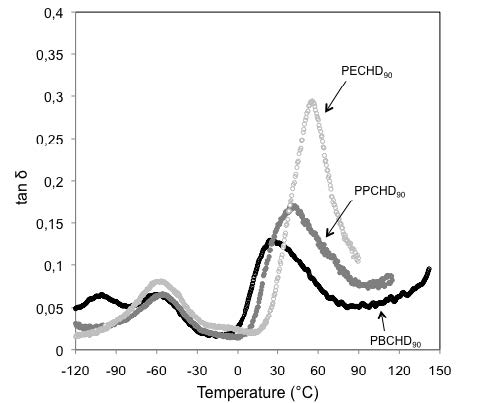 Figure 11. DMTA spectra of PxCHD90 samples.
Figure 11. DMTA spectra of PxCHD90 samples.
As regards the assignments of the observed relaxations, the α peak is assigned to the glass-to-rubber transition. From Figure 11 it is evident that these peaks shift to lower temperatures from PECHD90 to PBCHD90 due to a larger flexibility of a longer methylene sequence, according to the DSC results. Moreover, the intensity of the a peaks decreases from PECHD to PBCHD with the decrement of the amorphous phase amount.
As reported in [17], the β relaxation is due to the molecular motion of the cyclohexylene ring and the stereochemistry of the aliphatic ring influences the temperature of the peaks. In this case the three analyzed samples have the same percentage of trans isomer and the temperatures of the β relaxation are very close (about −60 °C).
The γ relaxation observed at about −100 °C for PBCHD90 sample may be associated with the motions of the -O-(CH2)4-O- units, likewise to the behavior of PBT (−80 °C) [17]. This relaxation has been studied in ref 17 and seems to depend on the amorphous amount: intensity and temperature of the peak decrease with the increment of the cis content and, then, with the increment of the amourphous phase amount. Therefore, the loss of the γ relaxation in the PPCHD90 and PECHD90 samples could be due to the fact that this process occurs at very low temperatures and with reduced intensity.
The solid state properties of alicyclic polyesters, characterized by the presence of the 1,4-cyclohexylene units, have been analyzed and correlated to their structure. In particular, the stoichiometry of the aliphatic ring and the length of the CH2 sequences have been taken into consideration.
The results obtained can be summarized as follows:
· Polymers rich in trans isomer are semicrystalline, whereas polymers rich in cis isomer are amorphous: indeed, the ring in cis configuration cause kinks and disturbances in the crystal formation. The exception is represented by PECHD90, which crystallizes with extremely slow rate, probably due to a high rigidity of the chains.
· The glass transition temperature decreases with the lengthening of the chain, due to the increment of chain flexibility.
· With respect to PET, PPT and PBT, the presence of the 1,4-cyclohexylene units, instead of aromatic rings, leads to lower transition temperatures but keep the same thermal stability.
· The crystalline phases of PxCHD90 samples changes as a function of the length of the diol.
· The crystallization kinetic data, obtained by the Avrami equation, suggest that the crystallization of PBCHD90 and PPCHD90 occurs with a heterogeneous nucleation process and a three dimensional growth, independently of the number of carbons in the diol. The crystallization rate significantly increases with the increment of the number of the methylene units in the diols.
As a conclusion, tunable properties can be easily obtained by varying stereochemistry and chain length of the diol in PxCHDy samples. This good property is associated to positive mechanical performance and a potential biodegradability.
All authors declare no conflicts of interest in this paper.
| [1] | Abbott A, De-Vita G (2012) Pairwise convergence of district-level house prices in London. Urban Stud 49: 719-738. |
| [2] | Barros C, Gil-Alana L, Payne J (2015) Modeling the long memory behavior in U.S. housing price volatility. J Hous Res 24: 87-106. |
| [3] |
Bayer P, Ellickson B, Ellickson P (2010) Dynamic asset pricing in a system of local housing markets. Am Econ Rev 100: 368-372. doi: 10.1257/aer.100.2.368

|
| [4] |
Brueckner J (1997) Consumption and investment motives and the portfolio choices of homeowners. J Real Estate Financ Econ 15: 159-180. doi: 10.1023/A:1007777532293

|
| [5] |
Case K, Cotter J, Gabriel S (2011) Housing risk and return: Evidence of a housing asset-pricing model. J Portf Manag 35: 89-109. doi: 10.3905/jpm.2011.35.5.089

|
| [6] |
Case K, Quigley J, Shiller R (2013) Wealth effects revisited 1975-2012. Crit Financ Rev 2: 101-128. doi: 10.1561/104.00000009

|
| [7] | Case K, Shiller R (1988) The behavior of home buyers in boom and post-boom markets. New Engl Econ Rev 6: 29-46. |
| [8] | Case K, Shiller R (1989) The efficiency of the market for single-family homes. Am Econ Rev 79: 125-37. |
| [9] |
Case K, Shiller R (1990) Forecasting prices and excess returns in the housing market. Am Real Estate Urban Econ Associ J 18: 253-73. doi: 10.1111/1540-6229.00521

|
| [10] |
Costello G, Fraser P, Groenewold N (2011) House prices, non-fundamental components and interstate spillovers: The Australian experience. J Bank Financ 35: 653-669. doi: 10.1016/j.jbankfin.2010.07.035

|
| [11] |
Crawford G, Fratantoni M (2003) Assessing the forecasting performance of regime-switching, ARIMA and GARCH models of house prices. Real Estate Econ 31: 223-243. doi: 10.1111/1540-6229.00064

|
| [12] | Crawford G, Rosenblatt E (1995) Efficient mortgage default option exercise: Evidence from loan loss severity. J Real Estate Res 10: 543-555. |
| [13] |
Cross R (1982) The Duhem-Quine thesis, Lakatos and the appraisal of theories in macroeconomics. Econ J 92: 320-340. doi: 10.2307/2232443

|
| [14] | Dale D, Wolf R, Yang HF (2015) An assessment of the risk and return of residential real estate. Manag Financ 41: 591-599. |
| [15] |
Dolde W, Tirtiroglu D (1997) Temporal and spatial information diffusion in real estate price changes and variances. Real Estate Econ 25: 539-565. doi: 10.1111/1540-6229.00727

|
| [16] |
Dolde W, Tirtiroglu D (2002) House price volatility changes and their effects. Real Estate Econ 30: 41-66. doi: 10.1111/1540-6229.00029

|
| [17] | Domian D, Wolf R, Yang HF (2015) An assessment of the risk and return of residential real estate. Manag Financ 41: 591-599. |
| [18] |
Engle R, Lilien D, Robbins R (1987) Estimating time varying risk premia in the term structure: The ARCH-M model. Econom 55: 391-407. doi: 10.2307/1913242

|
| [19] | Foster C, Order RV (1984) FHA terminations: A prelude to rational mortgage pricing. J American Real Estate Urban Econ Assoc 13: 273-291. |
| [20] |
Gallin J (2006) The long-run relationship between house prices and income: Evidence from local housing markets. Real Estate Econ 34: 417-438. doi: 10.1111/j.1540-6229.2006.00172.x

|
| [21] |
Goetzmann W (1993) The single family home in the investment portfolio. J Real Estate Financ Econ 6: 201-222. doi: 10.1007/BF01096958

|
| [22] | Goodhart C and Hoffman B (2007) House Prices and the Macroeconomy: Implications for Banking and Price Stability Oxford: Oxford University Press. |
| [23] |
Han L (2013) Understanding the puzzling risk-return relationship for housing. Rev Financ Stud 26: 877-928. doi: 10.1093/rfs/hhs181

|
| [24] | Harding S (1976) Can theories be refuted? Dordrecht: Springer. |
| [25] |
Holly S, Jones N (1997) House prices since the 1940s: cointegration, demography and asymmetries. Econ Model 14: 549-565. doi: 10.1016/S0264-9993(97)00009-6

|
| [26] |
Huang M, Wang TC (2015) Housing-bubble vulnerability and diversification opportunities during housing boom--bust cycles: evidence from decomposition of asset price returns. Ann Regional Sci 54: 605-637. doi: 10.1007/s00168-015-0669-x

|
| [27] |
Huang M, Wang TC (2017) An early alarm system for housing bubbles. Q Rev Econ Financ 63: 34-49. doi: 10.1016/j.qref.2016.04.014

|
| [28] |
Im K, Pesaran M, Shin Y (2003) Testing for unit roots in heterogeneous panels. J Econ 115: 53-74. doi: 10.1016/S0304-4076(03)00092-7

|
| [29] |
Lee C (2009) Housing price volatility and its determinants. Int J Hous Mark Anal 2: 293-308. doi: 10.1108/17538270910977572

|
| [30] |
Lee C (2017) An examination of the risk-return relation in the Australian housing market. Int J Hous Mark and Anal 10: 431-449. doi: 10.1108/IJHMA-07-2016-0052

|
| [31] | Lin P, Fuerst F (2014) Volatility clustering, risk-return relationship and asymmetric adjustment in Canadian housing markets. J Real Estate Portf Manag 20: 37-46. |
| [32] |
Nelson D (1991) Conditional heteroskedasticity in asset returns: A new approach. Econom 59: 347-370. doi: 10.2307/2938260

|
| [33] | Miles W (2008) Volatility clustering in U.S. home prices. J Real Estate Res 30: 73-90. |
| [34] | Miles W (2011) Clustering in U.K. home price volatility. J Hous Res 20: 87-100. |
| [35] | Miller N, Pandher G (2008) Idiosyncractic volatility and the housing market. J Hous Res 17: 13-32. |
| [36] |
Miller N, Peng L (2006) Exploring metropolitan price volatility. J Real Estate Financ Econ 33: 5-18. doi: 10.1007/s11146-006-8271-8

|
| [37] |
Morley B, Thomas D (2011) Risk-return relationships and asymmetric adjustment in the UK housing market. Appl Financ Econ 21: 735-742. doi: 10.1080/09603107.2010.535782

|
| [38] | Morley B, Thomas D (2016) An empirical analysis of UK house price risk variation by property type. Rev Econ Financ 6: 45-56. |
| [39] | Scruggs J (1998) Resolving the puzzling intertemporal relation between the market risk premium and conditional market variance: A two-factor approach. J Financ 26: 877-928. |
| [40] | Shafir E, Diamond P, Tversky A (1997) Money illusion Q J Econ 112: 341-374. |
| [41] |
Tsang CK, Wong WK, Horowitz I (2016) Arbitrage opportunities, efficiency, and the role of risk preferences in the Hong Kong property market. Stud Econ Financ 33: 735-754. doi: 10.1108/SEF-03-2015-0079

|
| [42] |
Wheaton W (2015) The volatility of real estate markets: A decomposition. J Portf Manag 41: 140-150. doi: 10.3905/jpm.2015.41.6.140

|
| [43] |
Zhou J, Gao Y (2012) Tail dependence in international real estate securities markets. J Real Estate Financ Econ 45: 128-151. doi: 10.1007/s11146-010-9249-0

|
| 1. | Avinash B. Lende, Saurav Bhattacharjee, Chung-Sung Tan, Production of Environmentally Friendly Polyester by Hydrogenation of Poly(butylene terephthalate) over Rh–Pt Catalysts Supported on Carbon Black and Recovery by a Compressed CO2 Antisolvent Technique, 2020, 59, 0888-5885, 21333, 10.1021/acs.iecr.0c04378 | |
| 2. | Han Na Kim, Daesun Park, Je Sung Youm, Bookyeong Jang, Jeong Cheol Kim, Effect of Dimethyl 1,4-Cyclohexane Dicarboxylate on Mechanical Properties and Crystallization Behavior of Polytrimethylene Terephthalate Co-Polymer, 2019, 27, 1598-5032, 182, 10.1007/s13233-019-7049-9 | |
| 3. | Sara Jalali, Reihaneh Rezaei, Mansoureh Ghanbar Afjeh, Niloofar Eslahi, Effect of Vanilla as a Natural Alternative to Traditional Carriers in Polyester Dyeing with Disperse Dyes, 2019, 20, 1229-9197, 86, 10.1007/s12221-019-8482-2 | |
| 4. | Melanie Hofmann, Jannis Sundermeier, Christoph Alberti, Stephan Enthaler, Zinc(II) acetate Catalyzed Depolymerization of Poly(ethylene terephthalate), 2020, 5, 2365-6549, 10010, 10.1002/slct.202002260 | |
| 5. | Andrei V. Kelarev, Xun Yi, Hui Cui, Leanne Rylands, Herbert F. Jelinek, A survey of state-of-the-art methods for securing medical databases, 2018, 5, 2375-1576, 1, 10.3934/medsci.2018.1.1 | |
| 6. | Avinash B. Lende, Saurav Bhattacharjee, Chung-Sung Tan, Hydrogenation of polyethylene terephthalate to environmentally friendly polyester over Vulcan XC-72 carbon supported Rh-Pt bimetallic catalyst, 2020, 09205861, 10.1016/j.cattod.2020.09.013 | |
| 7. | Alfred Bazin, Luc Avérous, Eric Pollet, Ferulic Acid as Building Block for the Lipase-Catalyzed Synthesis of Biobased Aromatic Polyesters, 2021, 13, 2073-4360, 3693, 10.3390/polym13213693 | |
| 8. | William Mawuko Kodzo Siegu, Lesly Dasilva Wandji Djouonkep, Naomie Beolle Songwe Selabi, Emmanuel Mintah Bonku, Zhengzai Cheng, Mario Gauthier, Synergistic Effect and Structure–Property of Bio-based 1,6-Hexanediol on Thermal, Mechanical and Degradation Properties of Biopolymers, 2023, 31, 1566-2543, 1144, 10.1007/s10924-022-02666-0 | |
| 9. | Avinash B. Lende, Saurav Bhattacharjee, Chung-Sung Tan, On-Water Hydrogenation of Polyethylene Terephthalate to Environmentally Friendly Polyester by the Catalyst Rh2.5Pt2.5/SBA-15, 2021, 9, 2168-0485, 7224, 10.1021/acssuschemeng.1c00218 | |
| 10. | Hassan Alshahrani, Azzam Ahmed, Hashim Kabrein, V. R. Arun Prakash, Mechanical Properties Study on Sandwich Composites of Glass Fiber Reinforced Plastics (GFRP) Using Liquid Thermoplastic Resin, Elium®: Preliminary Experiments, 2022, 12, 2079-6412, 1423, 10.3390/coatings12101423 | |
| 11. | Manuel Burelo, Itzel Gaytán, Herminia Loza-Tavera, Jorge A. Cruz-Morales, Daniel Zárate-Saldaña, M. Javier Cruz-Gómez, Selena Gutiérrez, Synthesis, characterization and biodegradation studies of polyurethanes: Effect of unsaturation on biodegradability, 2022, 307, 00456535, 136136, 10.1016/j.chemosphere.2022.136136 | |
| 12. | Hassan Alshahrani, Azzam Ahmed, Study on Flexural Behavior of Glass Fiber Reinforced Plastic Sandwich Composites Using Liquid Thermoplastic Resin, 2022, 14, 2073-4360, 4045, 10.3390/polym14194045 | |
| 13. | Gyuyeon Park, Ye Chan Kim, Minjeong Jang, Hyuna Park, Hong-Weon Lee, Wooyoung Jeon, Byung-Gee Kim, Kwon-Young Choi, Jungoh Ahn, Biosynthesis of aliphatic plastic monomers with amino residues in Yarrowia lipolytica, 2023, 10, 2296-4185, 10.3389/fbioe.2022.825576 | |
| 14. | In-Seok Yeo, Kang-Seok Go, Woo-Young Jeon, Min-Jeong Jang, Hye-Jeong Lee, Sung-Hwa Seo, Young Su Kim, HyunA Park, Byung-wook Min, Kyungmoon Park, Yung-Hun Yang, Kwon-Young Choi, Hong-Weon Lee, Sang-Goo Jeon, Jung-Oh Ahn, Integrating chemical and biological technologies in upcycling plastic waste to medium-chain α,ω-Diacid, 2024, 451, 09596526, 141890, 10.1016/j.jclepro.2024.141890 | |
| 15. | Fabricio Freije García, Guadalupe García Liñares, Use of Lipases as a Sustainable and Efficient Method for the Synthesis and Degradation of Polymers, 2024, 32, 1566-2543, 2484, 10.1007/s10924-023-03118-z | |
| 16. | Zehui Sun, Kaizhi Wang, Qiang Lin, Wendi Guo, Mugeng Chen, Chen Chen, Chi Zhang, Jiachen Fei, Yifeng Zhu, Jinbing Li, Yongmei Liu, Heyong He, Yong Cao, Value‐Added Upcycling of PET to 1,4‐Cyclohexanedimethanol by a Hydrogenation/Hydrogenolysis Relay Catalysis, 2024, 63, 1433-7851, 10.1002/anie.202408561 | |
| 17. | Zehui Sun, Kaizhi Wang, Qiang Lin, Wendi Guo, Mugeng Chen, Chen Chen, Chi Zhang, Jiachen Fei, Yifeng Zhu, Jinbing Li, Yongmei Liu, Heyong He, Yong Cao, Value‐Added Upcycling of PET to 1,4‐Cyclohexanedimethanol by a Hydrogenation/Hydrogenolysis Relay Catalysis, 2024, 136, 0044-8249, 10.1002/ange.202408561 |
| Samples | Trans % of the ring in the polymer a) | Mw × 10-3 b) | Mw/Mn b) |
| PECHD50 | 53 | 84.1 | 2.5 |
| PPCHD50 | 53 | 62.4 | 2.4 |
| PBCHD50 | 52 | 88.6 | 2.8 |
| PECHD90 | 87 | 85.6 | 2.5 |
| PPCHD90 | 87 | 65.6 | 2.5 |
| PBCHD90 | 91 | 54.9 | 2.3 |
| PET | - | 55.0 | 2.4 |
| PPT | - | 60.7 | 2.8 |
| PBT | - | 110.0 | 2.6 |
| a) Calculated by 1H NMR; b) Measured by GPC in CHCl3 for PxCHD samples and in CHCl3/HFIP (98/2 vol%) mixture for PxT samples. | |||
| Samples | TDa) | Tcb) | ΔHcb) | Tgc) | Tccc) | ΔHccc) | Tmc) | ΔHmc) | Tmo d) |
| (°C) | (°C) | (J·g-1) | (°C) | (°C) | (J·g-1) | (°C) | (J·g-1) | (°C) | |
| PECHD50 | 460 | - | - | 14 | - | - | - | - | - |
| PPCHD50 | 431 | - | - | -1 | - | - | - | - | - |
| PBCHD50 | 433 | - | - | -9 | - | - | - | - | - |
| PECHD90 | 462 | - | - | 24 | 113 | 3 | 145 | 4 | Nd e) |
| PPCHD90 | 432 | 71 | 19 | 7 | 67 | 11 | 140 | 29 | 152 |
| PBCHD90 | 433 | 132 | 43 | 5 | - | - | 150–158 | 46 | 170 |
| PET | 451 | 188 | 34 | 82 | - | - | 254 | 31 | 272 |
| PPT | 418 | 174 | 47 | 54 | - | - | 230 | 54 | 241 |
| PBT | 408 | 192 | 57 | 42 | - | - | 217–223 | 55 | 233 |
| a)Temperature of the maximum degradation rate measured in TGA under nitrogen flow at 10 °C·min−1; b) Measured in DSC during the cooling scan at 10 °C·min−1; c) Measured in DSC during the second heating scan at 10 °C·min−1; d) calculated by Hoffmann-Weeks equation; e) not determined. | |||||||||
| Samples | Tca) | ΔHca) | Tgb) | Tccb) | ΔHccb) | Tmb) | ΔHmb) |
| (°C) | (J·g-1) | (°C) | (°C) | (J·g-1) | (°C) | (J·g-1) | |
| PECHD90 | 91 | 23 | 27 | - | - | 143 | 23 |
| PPCHD90 | 101 | 41 | 11 | - | - | 130–141 | 41 |
| PBCHD90 | 142 | 42 | - | - | - | 155 | 42 |
| a)Measured in DSC during the cooling scan at 1 °C·min−1; b) Measured in DSC during the second heating scan at 10 °C·min−1. | |||||||
| Samples | Tc (°C) | t1/2 (s) | n | k (s-n) |
| PPCHD90 | 96 | 236 | 2.3 | 1.8 × 10-6 |
| 98 | 265 | 2.3 | 2.5 × 10-6 | |
| 100 | 319 | 2.4 | 7.6 × 10-7 | |
| 102 | 380 | 2.3 | 1.1 × 10-6 | |
| 104 | 462 | 2.4 | 5.3 × 10-7 | |
| PBCHD90 | 138 | 80 | 3.0 | 1.5 × 10-6 |
| 140 | 112 | 2.7 | 1.9 × 10-6 | |
| 142 | 180 | 2.6 | 7.5 × 10-7 | |
| 144 | 280 | 2.7 | 1.9 × 10-7 | |
| 146 | 604 | 2.9 | 8.4 × 10-9 | |
| PET | 201 | 299 | 2.1 | 4.6 × 10-6 |
| 203 | 325 | 2.0 | 7.5 × 10-6 | |
| 205 | 460 | 2.2 | 1.1 × 10-6 | |
| 207 | 480 | 2.2 | 5.0 × 10-6 | |
| 210 | 544 | 2.0 | 3.4 × 10-6 | |
| PPT | 191 | 102 | 2.3 | 2.0 × 10-5 |
| 193 | 122 | 2.2 | 1.7 × 10-5 | |
| 195 | 258 | 2.1 | 6.3 × 10-6 | |
| 197 | 433 | 2.4 | 4.0 × 10-7 | |
| 199 | 551 | 2.5 | 1.2 × 10-7 | |
| PBT | 196 | 72 | 2.6 | 1.2 × 10-5 |
| 198 | 116 | 2.5 | 5.1 × 10-6 | |
| 200 | 219 | 2.4 | 1.4 × 10-6 | |
| 202 | 310 | 2.6 | 2.4 × 10-7 | |
| 204 | 649 | 2.6 | 2.7 × 10-8 |
| Samples | Trans % of the ring in the polymer a) | Mw × 10-3 b) | Mw/Mn b) |
| PECHD50 | 53 | 84.1 | 2.5 |
| PPCHD50 | 53 | 62.4 | 2.4 |
| PBCHD50 | 52 | 88.6 | 2.8 |
| PECHD90 | 87 | 85.6 | 2.5 |
| PPCHD90 | 87 | 65.6 | 2.5 |
| PBCHD90 | 91 | 54.9 | 2.3 |
| PET | - | 55.0 | 2.4 |
| PPT | - | 60.7 | 2.8 |
| PBT | - | 110.0 | 2.6 |
| a) Calculated by 1H NMR; b) Measured by GPC in CHCl3 for PxCHD samples and in CHCl3/HFIP (98/2 vol%) mixture for PxT samples. | |||
| Samples | TDa) | Tcb) | ΔHcb) | Tgc) | Tccc) | ΔHccc) | Tmc) | ΔHmc) | Tmo d) |
| (°C) | (°C) | (J·g-1) | (°C) | (°C) | (J·g-1) | (°C) | (J·g-1) | (°C) | |
| PECHD50 | 460 | - | - | 14 | - | - | - | - | - |
| PPCHD50 | 431 | - | - | -1 | - | - | - | - | - |
| PBCHD50 | 433 | - | - | -9 | - | - | - | - | - |
| PECHD90 | 462 | - | - | 24 | 113 | 3 | 145 | 4 | Nd e) |
| PPCHD90 | 432 | 71 | 19 | 7 | 67 | 11 | 140 | 29 | 152 |
| PBCHD90 | 433 | 132 | 43 | 5 | - | - | 150–158 | 46 | 170 |
| PET | 451 | 188 | 34 | 82 | - | - | 254 | 31 | 272 |
| PPT | 418 | 174 | 47 | 54 | - | - | 230 | 54 | 241 |
| PBT | 408 | 192 | 57 | 42 | - | - | 217–223 | 55 | 233 |
| a)Temperature of the maximum degradation rate measured in TGA under nitrogen flow at 10 °C·min−1; b) Measured in DSC during the cooling scan at 10 °C·min−1; c) Measured in DSC during the second heating scan at 10 °C·min−1; d) calculated by Hoffmann-Weeks equation; e) not determined. | |||||||||
| Samples | Tca) | ΔHca) | Tgb) | Tccb) | ΔHccb) | Tmb) | ΔHmb) |
| (°C) | (J·g-1) | (°C) | (°C) | (J·g-1) | (°C) | (J·g-1) | |
| PECHD90 | 91 | 23 | 27 | - | - | 143 | 23 |
| PPCHD90 | 101 | 41 | 11 | - | - | 130–141 | 41 |
| PBCHD90 | 142 | 42 | - | - | - | 155 | 42 |
| a)Measured in DSC during the cooling scan at 1 °C·min−1; b) Measured in DSC during the second heating scan at 10 °C·min−1. | |||||||
| Samples | Tc (°C) | t1/2 (s) | n | k (s-n) |
| PPCHD90 | 96 | 236 | 2.3 | 1.8 × 10-6 |
| 98 | 265 | 2.3 | 2.5 × 10-6 | |
| 100 | 319 | 2.4 | 7.6 × 10-7 | |
| 102 | 380 | 2.3 | 1.1 × 10-6 | |
| 104 | 462 | 2.4 | 5.3 × 10-7 | |
| PBCHD90 | 138 | 80 | 3.0 | 1.5 × 10-6 |
| 140 | 112 | 2.7 | 1.9 × 10-6 | |
| 142 | 180 | 2.6 | 7.5 × 10-7 | |
| 144 | 280 | 2.7 | 1.9 × 10-7 | |
| 146 | 604 | 2.9 | 8.4 × 10-9 | |
| PET | 201 | 299 | 2.1 | 4.6 × 10-6 |
| 203 | 325 | 2.0 | 7.5 × 10-6 | |
| 205 | 460 | 2.2 | 1.1 × 10-6 | |
| 207 | 480 | 2.2 | 5.0 × 10-6 | |
| 210 | 544 | 2.0 | 3.4 × 10-6 | |
| PPT | 191 | 102 | 2.3 | 2.0 × 10-5 |
| 193 | 122 | 2.2 | 1.7 × 10-5 | |
| 195 | 258 | 2.1 | 6.3 × 10-6 | |
| 197 | 433 | 2.4 | 4.0 × 10-7 | |
| 199 | 551 | 2.5 | 1.2 × 10-7 | |
| PBT | 196 | 72 | 2.6 | 1.2 × 10-5 |
| 198 | 116 | 2.5 | 5.1 × 10-6 | |
| 200 | 219 | 2.4 | 1.4 × 10-6 | |
| 202 | 310 | 2.6 | 2.4 × 10-7 | |
| 204 | 649 | 2.6 | 2.7 × 10-8 |